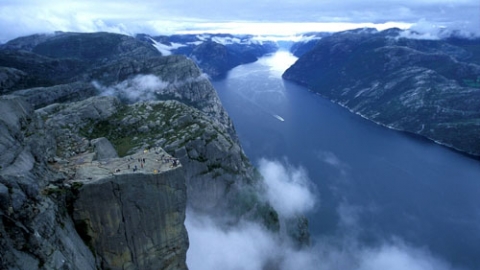My 8-day itinerary covered three countries including Stockholm, Kiruna, Jukkasjarvi, Rovaniemi, Kemi, Saariselka, Kirkenes and Oslo.
DAY 1: TRAVEL BACK IN TIME TO THE MEDIEVALS IN STOCKHOLM, SWEDEN
In the Swedish capital Stockholm, I spent a day traveling back in time to the Middle Ages by strolling the narrow, winding cobblestone streets of the 800-year-old Gamla Stan old town, admiring the red, yellow, and green painted houses and the frescoes on their facades. Much of the city’s charm is preserved in Gamla Stan, home to Stockholm’s Royal Palace.
Many street names in Stockholm date back to the Middle Ages, such as Kopmangatan (Merchant Street); Skomakargatan (Shoemaker Street) from the 14th century; Slottbacken (Castle Slope); Jarntorget (Iron Square); Kåkbrinken (Old Gorge Mound) and others from the 5th century.

Stockholm, the capital of Sweden
From Gambla Stan, I went to the north of Stockholm's oldest square, Stortorget, and stopped by the Nobel Museum in the old Stock Exchange Building to see exhibits about the Nobel Prize and Nobel Prize winners, as well as information about Alfred Nobel – the founder of the prize.
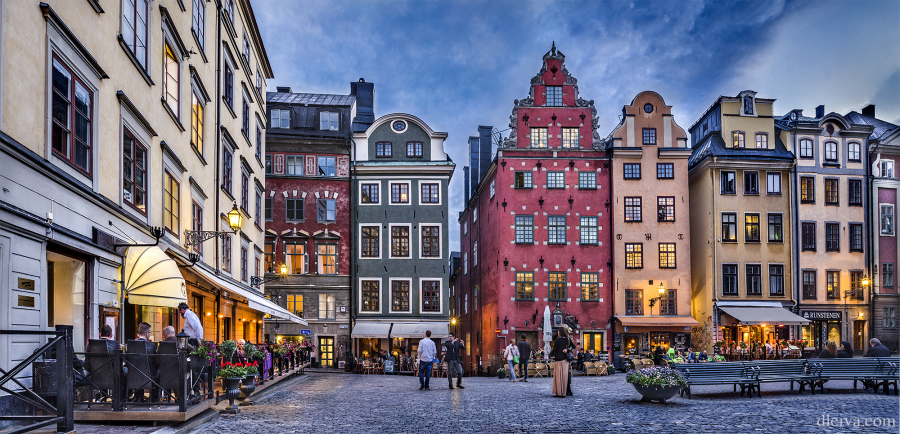
Stortorget Square is the oldest in Stockholm
About 200 meters from the Nobel Museum, I walked to the Storkyrkan Church - a medieval church, built in 1279, containing many antiques, the most prominent of which is an oil painting called Vadersolstavlan (English meaning Sundog Painting), depicting a sundog in Stockholm in 1535. A sundog is a phenomenon of a ring or a halo around the sun and the reason they are called sundogs is because they follow the sun like a dog follows its owner.

Storkyrkan Church was built in the Middle Ages.

Leaving Storkyrkan Church, I walked another 200 meters in the old town of Gambla Stan, to take souvenir photos outside the Royal Palace of Stockholm - the official residence of the Swedish king, built in the artistic style originating from the Italian Renaissance, one of the largest palaces in the world with more than 600 rooms. Inside the palace there is also the Treasury - where royal costumes, armor, swords are displayed...

Stockholm Royal Palace
At the end of the day, I did not forget to take a picture of Riddarholmen Church - the oldest architectural work in the old town of Gamla Stan, which used to be the place where the royal coronation ceremony was held. Inside the church, there are many valuable wooden sculptures with the main style of primitive red bricks, creating a special color and ancient features. Each ancient architectural work always exudes a beauty in harmony with nature and life. This is one of the most beautiful churches in Sweden and is also the only remaining medieval monastery.

Riddarholmen Church in the old town of Gamla Stan
DAY 2: ARCHIPELAGO ARCHIPELAGO AND SWEDISH'S DJURGARDEN ISLAND
In the morning, I drove from the center of Stockholm to the Archipelago, located right at the meeting point of Lake Malaren and the Baltic Sea. The Archipelago has about 30,000 large and small islands with flat rocky island structures, not undulating like Ha Long Bay in Vietnam. On the islands, there are often clusters of small wooden houses, which are the weekend getaways of city residents.
There, I bought a 3-hour boat tour to visit the island. The boat has many rows of seats for tourists to enjoy the scenery and take them to explore some other islands in the vicinity. Sitting on the boat, I saw with my own eyes dozens of massive cruise ships, dozens of stories high and as long as a city block, sailing back and forth on the Baltic Sea, carrying tourists from Sweden to Denmark, Norway, etc. It was so peaceful to sit on the rocky shore, breathe the fresh air, enjoy the warm sunshine and feel the beauty of the rocky islands and the deep green water of the Baltic Sea.

Archipelago
On the way back to central Stockholm, I stopped by Djurgarden Island, located right in the middle of Stockholm. It is a great place for locals to stroll, have picnics or relax at the Grona Lund amusement park. On the island, I visited Skansen Village – considered the oldest open-air museum in the world, which preserves traditional Swedish rural culture as well as the Sami culture of the northernmost land of Europe. Skangen has more than 150 historical buildings including churches, schools, houses, shops… from centuries ago, giving you a glimpse of life in pre-industrial Sweden. I also went to the Vasa Museum (also known as the naval museum in Stockholm) to see the 69-meter-long Royal warship, launched in the 17th century, displayed intact in the world.

The village of Skansen preserves traditional Swedish rural culture


DAY 3: LAPLAND'S KIRUNA TOWN AND THE AURORA LIGHTS IN THE JUKKASJARVI REGION
I took a 1 hour 35 minute flight from Stockholm to Kiruna – Sweden’s northernmost town, located in the province of Lapland. In Kiruna, I headed to the village of Jukkasjarvi, 20 km away, for a short Snowmobile ride. With the help of professional snowmobile drivers, I went to see the northern lights at the Aurora Colosseum.
In the evening, I gathered around the fire with the other travelers, enjoying dinner served by the river. What could be more wonderful than sitting on the reindeer skins to admire the northern lights - one of the seven mysterious phenomena of nature. The weather was very favorable that day and I clearly saw the northern lights shining brightly in the sky of Jukkasjarvi.
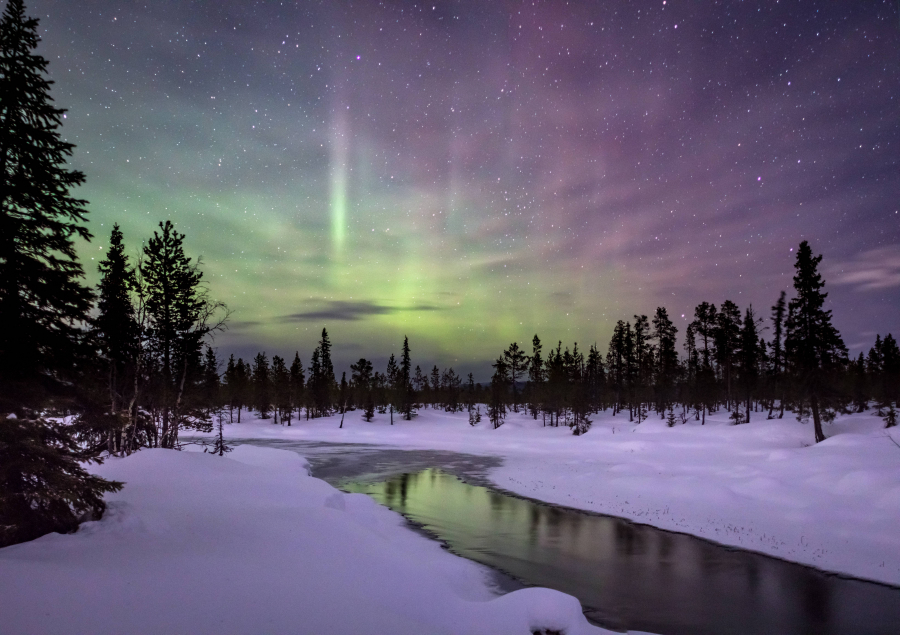
Northern Lights in Jukkasjarvi, Sweden
DAY 4: SANTA CLAUS' HOMETOWN IN ROVANIEMI, FINLAND
From the town of Kiruna, I traveled about 350 km to the capital Rovaniemi of Lapland province, Finland. Through brand promotion campaigns, Rovaniemi has always been seen as the "official hometown of Santa Claus". Every Christmas, Santa Claus Village becomes an ideal tourist destination, attracting both adults and children. Santa Claus's house is located in a village, right on the Arctic Circle, where he lives and works all year round.

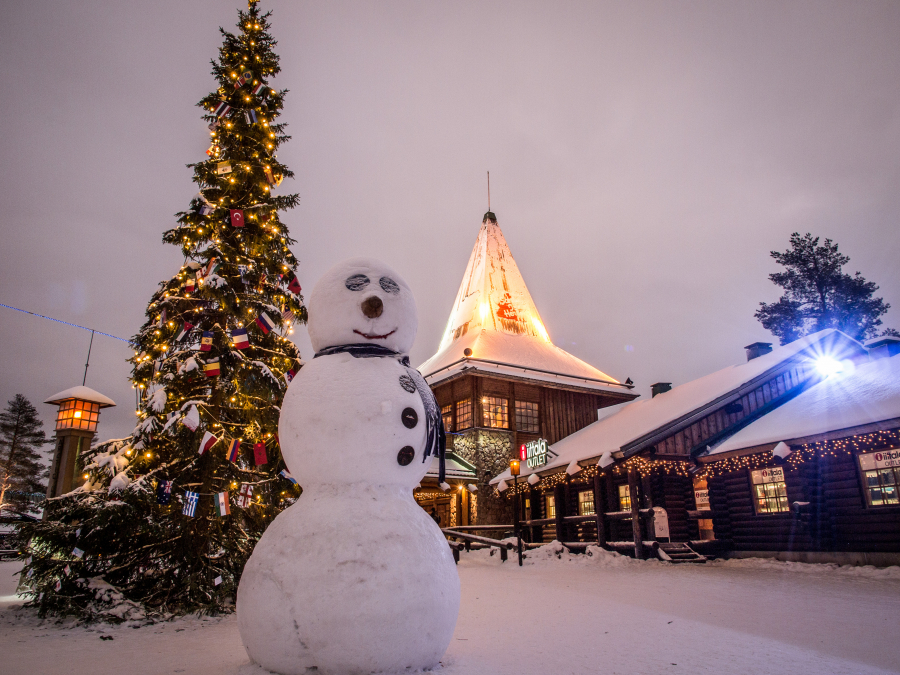
Santa Claus Village in Rovaniemi
Santa Claus, also known as Father Christmas or Santa Claus, is an image that has long existed in many cultures. According to legend, Santa Claus lives in the North Pole on a mountain range shaped like an ear, so he can listen to the wishes of children around the world. He lives with the elves and spends his time preparing gifts for children. He receives many letters from children around the world on Christmas. On Christmas Eve, he begins his journey with a sleigh pulled by 8 reindeer to bring gifts and toys to children.
There is a lot of information that Santa Claus is real, the incarnation of Saint Nicolas who lived in the 4th century, known as “Santa Claus”. Saint Nicolas was the only son in a wealthy aristocratic family in Northern Europe. He lived a kind life since childhood and decided to become a monk, but his family was poor, so he had to stay at home to take care of his elderly parents. He devoted his life to serving God, often helping many poor families in trouble in the area. After his parents passed away, Nicolas entered the seminary and was ordained a priest. Especially in December every year, he had the habit of bringing gifts, cakes, and toys to poor children in the area, also to remind everyone that Christmas had come. Since then, people have called Saint Nicolas “Santa Claus”.
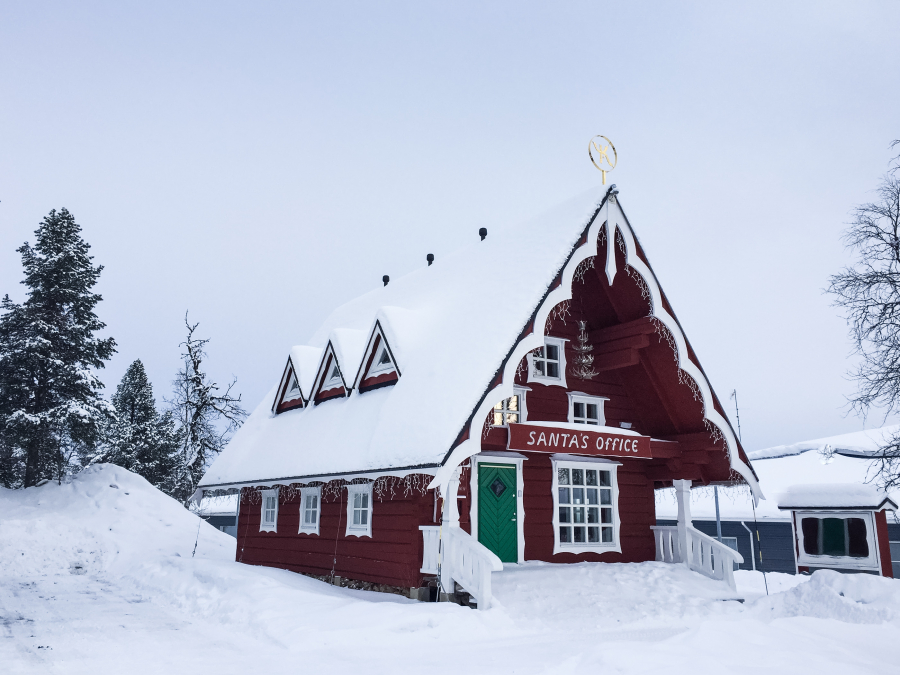
In Rovaniemi, I met, talked and took souvenir photos with Santa Claus. For a service fee, the staff in Santa Claus village took my photo and saved it as digital data. You can choose two different prices: buy the photo data and take it home to print it yourself or buy a 20 x 30 cm print. There is also an official Santa Claus post office, where visitors can buy postcards, fill in the recipient's information and send them with the "exclusive" stamp of Santa Claus village.

Santa Claus's office in Rovaniemi

Postcards with Santa Claus
I went to the Arktikum Science Center – a museum with a unique and strange architectural design with a long cylindrical glass dome built above ground, while the museum is completely underground. There is a garden where visitors can learn about the adaptation of plants to harsh winters like Lapland, along with famous Finnish monuments and sculptures.
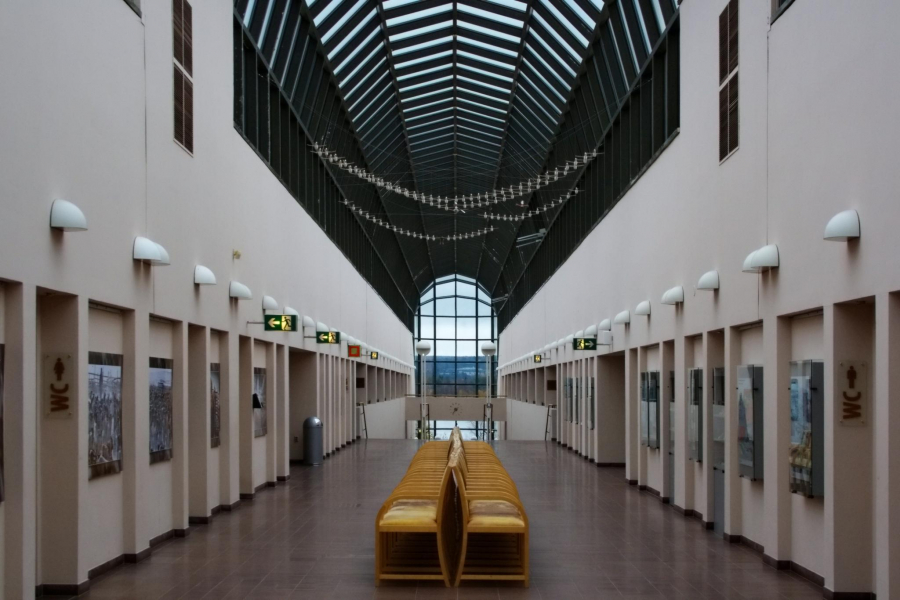
Arktikum Science Center in Rovaniemi
To add more fun to the trip, I visited the Husky Farm and experienced dog sledding. The adorable Siberian Husky dogs would be the “professional drivers” to take me around, admiring the white snow scenery on the sled. I did not forget to take pictures with the Husky “drivers” because they were specially trained and this helped me capture some great photos.
Especially in Rovaniemi, when I set foot on the white painted line with the words Arctic Circle, I received a Certificate of having crossed the Arctic Circle - one of the 5 important parallels on the map of the earth. At the end of the day, I went to Kemi, about 120 km away, near the sea to stay one night in Kemi, convenient to take the icebreaker the next morning.

Husky farm and dog sledding

DAY 5: ADVENTURE IN THE ICE ON THE ICEBREAKER SAMPO IN KEMI
I went to Ajos port in Kemi (the official port of Santa Claus’s hometown) and started my experience on the Sampo icebreaker – once used by the Finnish government as the country’s icebreaker. Drifting on the Bothnian ice fjord gave me unique experiences and beautiful marks in my travel diary.
The Sampo icebreaker is 78 m long, 14 m wide, can accommodate 199 passengers, and sails through the cold regions very peacefully. Many tourists are surprised by the operating mechanism of this unique winter warship when it glides through the super-dense ice blocks but is still as gentle as a boat cutting through the water in the middle of the river. If tropical beaches are the ideal place to enjoy fun activities on the water, then the seemingly cold ice seas in Finland are the ultimate challenge for brave people.

Icebreaker Sampo
For a new experience, I got off the ship and swam in the icy lake. Under the thick, icy layer of ice, there were many ocean currents. The clear water under the cold snow was not as cold as on the surface. The heat from the earth's core always kept the water warm.
Kemi is also famous for its giant Ice Castle. It is built in winter but will melt and disappear without a trace when spring comes because the main component of the castle is made of ice and snow. In the following winter, they continue to build another ice castle with different shapes.
The castle is surrounded by ice walls nearly 4 meters high, and inside there is a hotel, art gallery and church. The areas inside the castle are lit with colorful lights, making the walls made of snow and ice even more sparkling. At the castle, if you like, you can rent a hotel room, sleep on carpets and blankets made of reindeer skin.



DAY 6: SEE THE AURORA LIGHTS THROUGH THE GLASS-COVERED IGNIGN KAKSLAUTTANEN IN SAARISELKA
From Kemi, I traveled to the year-round cold, sparsely populated village of Saariselka, which is home to a special phenomenon called the Northern Lights. Saariselka is located in the mountainous region of northern Finland, part of the Urho Kekkonen National Park, about 260 km from Rovaniemi.
The amazing natural phenomenon of the northern lights has attracted tourists from all over the world to admire it through a unique glass igloo called Kakslauttanen. This is a hotel consisting of igloos designed in the style of the Eskimos. What is more special is that these igloos are equipped with heat-retaining glass, so even if the outside temperature drops to -30 degrees and is covered with snow, the inside is still warm.
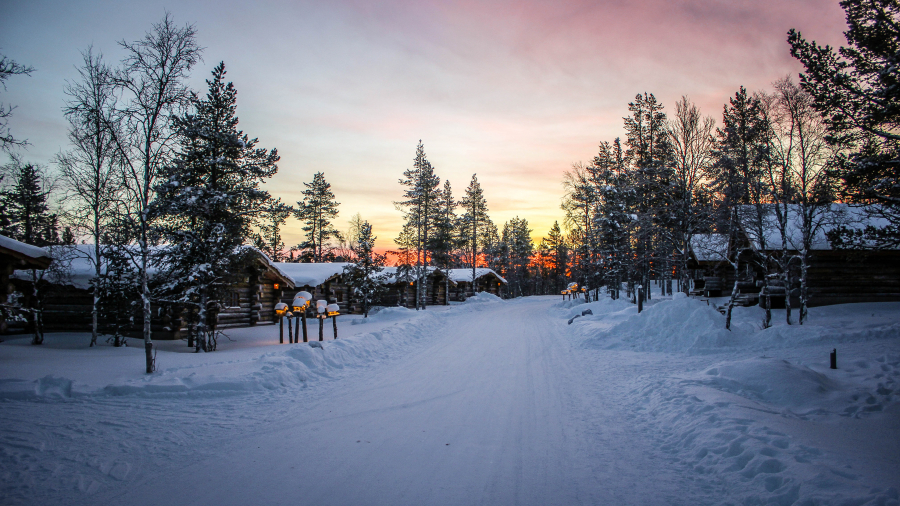
Saariselka Village in Finland
The Kakslauttanen Hotel complex has many styles of rooms such as glass-paneled tents, traditional log houses... equipped with modern facilities like a 5-star hotel with full bathrooms, luxury beds, sauna and snow restaurant. Every year this complex is open for a few winter months depending on weather conditions.

Kakslauttanen Glass Igloo
What could be more wonderful than lying on the soft striped bed, looking up through the glass to admire the magical beauty of the northern lights. The aurora borealis at first glance looks like a colorful curtain hanging under the cold night sky with thousands of twinkling stars, covering the snow-white pine forest.

Inside the Kakslauttanen Igloo
This optical phenomenon is caused by the interaction of charged particles from the solar wind with the Earth's upper atmosphere. The Northern Lights come in many different magical colors, but the vast majority are green and purple.
DAY 7: WATCH KING CRAB CATCHING IN KIRKENES TOWN, NORWAY
I set off from Saariselka to Kirkenes, about 213 km away – a town in the northernmost part of Norway, near the border between Norway and Finland. Kirkenes means church on the cape and it is located between two rocky fjords, leading to the Barents Sea. It is a paradise for the world’s largest King crab, which only lives in very cold and deep waters of 200-400 m such as in the far north, Alaska (USA), northwest Canada…
There are three species of King crab: the blue crab (Paralithodes platypus), the red crab (Paralithodes camtschaticus) and the yellow crab (Lithodes aequispinus). The yellow crab is the smallest, weighing an average of 2.2 kg to 4 kg. The red crab is the most expensive and is sold all over the world.
Upon arrival, I joined the tourists in watching the King crab catching program. King crab catching often encounters many obstacles because fishermen have to go out to sea during the stormy season with temperatures below 0oC. People use round or square steel cages, woven with nets to catch crabs on the seabed. On average, each cage weighs hundreds of kilograms. The king crabs are very large, but fishermen are not allowed to catch all the crabs that float to the surface. Those that are too small must be released back into the sea to grow up according to regulations.
In the special suit, I can also experience the exciting crab catching and enjoy the fresh King crab specialty that I just caught. The cold of the Arctic region makes my sea trip more interesting.
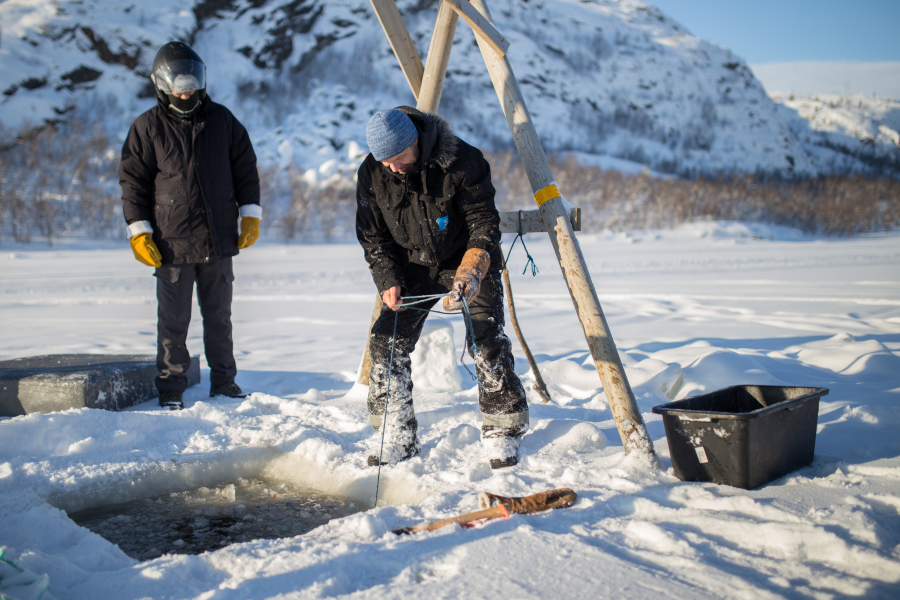
Watch King Crab Catching in Kirkenes, Norway
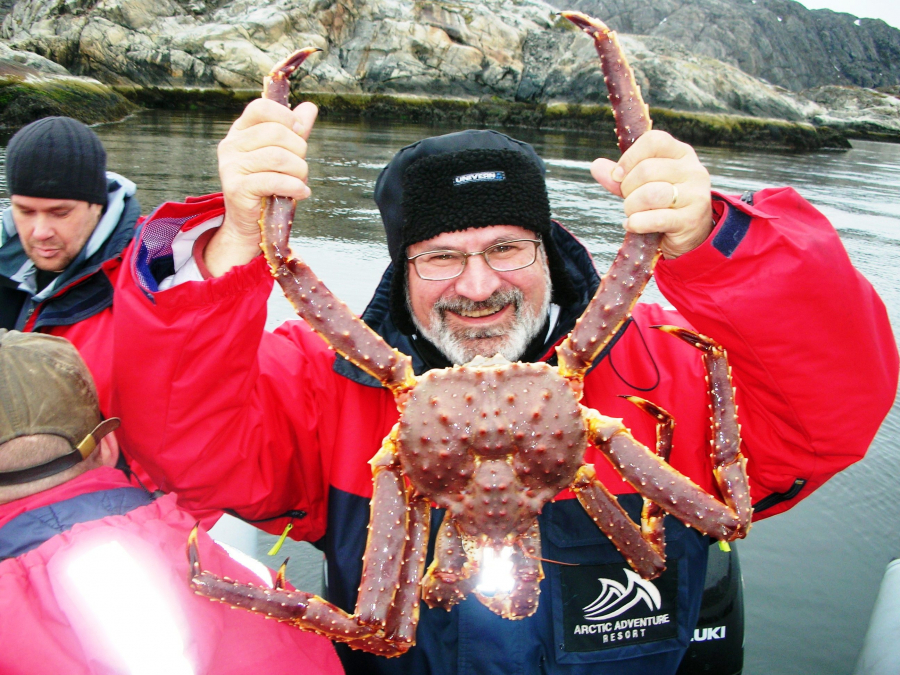
Tourists experience catching King crabs
DAY 8: OSLO, NORWAY
In the morning, I went to Kirkenes airport to catch a flight to Oslo, the capital of Norway. As the oldest city in Scandinavia, Oslo was founded in the early 11th century and became the capital of Norway in the 13th century. Since then, Oslo has developed into a beautiful city with sea and mountains on both sides. I spent the last day of the trip walking, using public transport and taking great pictures of the landscape.
The first attraction in Oslo is Akershus Castle – built in 1299, once the residence of the Norwegian Royal Family, then became a fortress in 1592, then rebuilt as a Renaissance castle between 1637 and 1648. Akershus includes several large halls, Akershus Church and the Royal Mausoleum, a model of a castle including the permanent government house and halls where grand banquets are held. The small historic church at Akershus Castle is now the tomb of the Norwegian Royal Family.
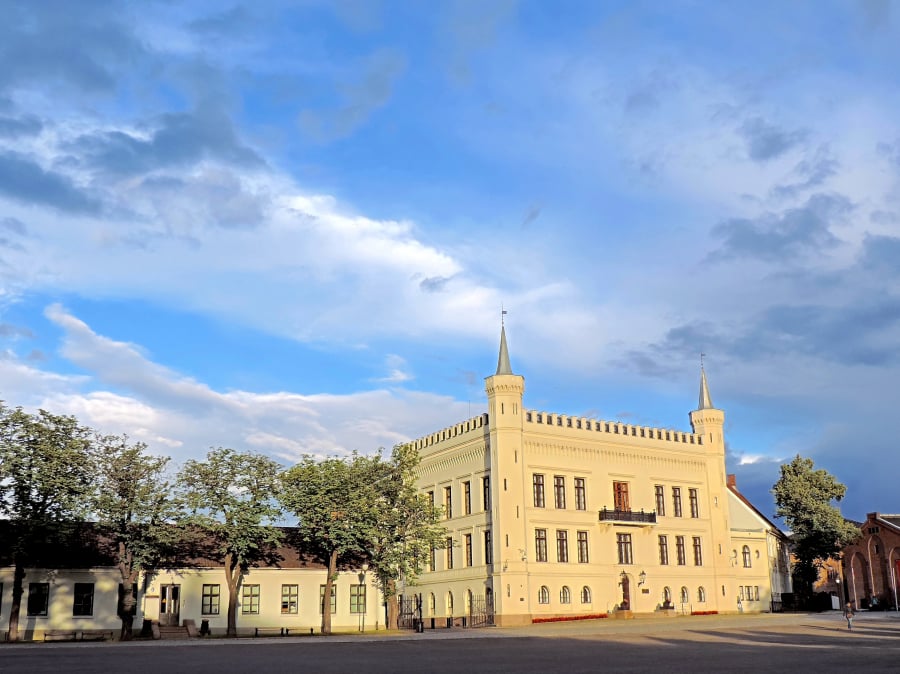
Akershus Castle in Oslo
The next stop was the Nobel Peace Center. Most people know that the Nobel Prize is awarded annually in Stockholm, Sweden. But few people know that the Nobel Peace Prize is awarded in Oslo, Norway. In front of the building is a large square overlooking the Oslo harbor and ferry terminal, which is a great place for me to take a photo and check in.
Oslo City Hall (Radhuset) is architecturally similar to its Stockholm cousin, with its murals depicting Norwegian history and legends and is a free attraction in the city. Inside, the walls are decorated with paintings from the first half of the 20th century on the theme of Norwegian culture and life.
Afterwards, I went to the Viking Ship Museum – which displays three ships built in the 9th century and found in southern Norway in the 12th century. This is a typical Viking ship, long and narrow, more than 20 meters long, 5 meters wide, used for long voyages.
At the end of the day, Frogner Park was the perfect place to end my three-country journey.
This is the largest park in central Oslo, home to the world-famous Vigelandsparken. The park has 200 fountains and beautiful sculptures by Gustav Vigeland. Frognerparken also has a collection of 14,000 plants and 150 species of roses, the largest in Norway.

 VI
VI EN
EN













.jpg.jpg)











